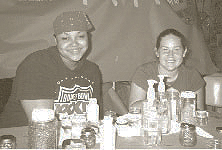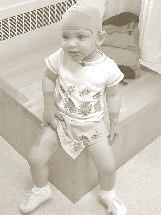Helping Traumatized Children Reclaim Life
Written by Megan Bronson RN, MSN, CS on August 29, 2019
It is a well-established fact that burns and the painful, invasive procedures required to heal them are traumatic for children as well as adults. Traumatic experiences such as severe burns have a profound effect on the developing child and can overwhelm their coping abilities.
Trauma can be defined as any event that is experienced directly or is witnessed by the child and that is perceived as life threatening to themselves or others. Traumatic events elicit feelings of terror, powerlessness, and often horror and rage. Burn trauma overwhelms the body and its defenses and it also overwhelms the mind and its defenses.
THE EFFECTS OF TRAUMA:
Trauma triggers the most basic and instinctual survival responses in the brain and body and puts the traumatized child’s brain on red alert chemically. The survival instincts in traumatic situations cause an individual to either fight, flee or freeze. These responses prepare the body for defense in a traumatic situation.
In a very interesting study published in a 1996 Infant Mental Health Journal, Bruce Perry, M.D., Ph.D. et al. focused on the long-term effects of trauma on children’s brain development. The authors noted that when children are not assisted in dealing with the trauma and moving out of the trauma response they may develop a persistent fear state over time. (Indicators of fear or anxiety states for different developmental stages are listed in the table on page 9.)

Miranda and Audra find lots to smile about at burn camp.
Younger children will generally go into a freeze response when trauma occurs, as they are ill prepared to fight or flee. The freeze response is characterized by a numbing of feelings and perceptions. The younger and more helpless the child, the more likely they are to use a dissociative response. If left untreated these children can develop anxiety and depressive disorders.
(Note to burn center staff: The authors noted that anything that can decrease the intensity and duration of the acute phase of response to trauma would decrease the probability of developing neuropsychiatric symptoms later on. This study has profound implications for burn centers in terms of the timely, adequate, and appropriate management of procedural pain and anxiety in children suffering burn trauma. Perry’s study also noted that once the child’s brain is sensitized to trauma, a full blown trauma response pattern could be elicited by even minor stressors.)
INCOMPLETE MASTERY OR HEALING OF TRAUMATIC STATES
The symptoms of trauma may not appear or develop for weeks, months, or sometimes even years after the burn trauma occurs. Many children develop some symptoms of Acute Stress Disorder after burn trauma . Some will go on to develop Post Traumatic Stress Disorder. Untreated, these children can also develop anxiety and depressive disorders, as well as behavioral disorders and substance abuse problems.
In the article Body Image Development in the Burned Child, Freddrick Stoddard, M.D. recognizes the long-term effects of childhood trauma when there is incomplete mastery of the anxiety and fear related to the trauma. The study lists the following possible long term effects of unmastered trauma: pessimistic life attitudes, alterations in personality, diminished self esteem, distorted body image, disturbances in interpersonal relationships, estrangement, depression, anxiety disorders, and depressive disorders. Many adult burn survivors who were burned as children suffer from these long-term problems.

Makayla Rennels wears her pressure garments.
INTERVENTION:
The effects of trauma impact the child on a cognitive, emotional and social level. Trauma also affects the way the child feels about themselves and in relationship to others. Helping the child after trauma requires addressing all of these areas.
The most essential psychological and social interventions for children after burn trauma are those that are aimed at reestablishing physical and psychological safety. This is true in all phases of the recovery process of burns, from acute hospitalization through rehabilitation, to return to home and school. The Perry study gives clear direction for early intervention with the traumatized child and suggests that providing structure, predictability, and nurturing the child are the key elements of effective intervention.
YOU CAN BE HELPFUL IMMEDIATELY AFTER THE TRAUMA BY:
Providing consistent and reliable support from a limited number of caregivers.
Establishing a predictable routine that the child can rely on. If this routine needs to vary, inform the child ahead of time of the change.
Following the child’s lead in discussing the trauma. Let the child bring this up.
Allowing the child to talk about the trauma; however, do not prod or push to do this.
AS THE CHILD MOVES OUT OF PHYSICAL CRISIS:
The child needs patience, love, and permission to grieve.
Allowing the child too much control can actually make the child feel more insecure.
Set firm, clear limits and follow through with consequences the child has been informed of ahead of time. This helps the child to reestablish a sense of predictability in their world.
Provide hugs, holding, and gentle physical reassurance. Holding the child if physically possible while reading a book or sitting close to an older child is a wonderful way to provide physical contact and reassurance.
Return to pre-trauma routines, such as bedtime rituals, family time, meal times, limits etc. Remember to give time and attention to other children in the family as well. This helps reestablish normalcy in the family and helps prevent alienation of the burned child from their siblings.
Provide the child with age appropriate information.
Help children regain a sense of control over their lives by providing choices.
DURING REHABILITATION:
Help the child to find appropriate ways to discharge anxiety and anger associated with trauma through age appropriate physical activities.
Assist the child in setting small, measurable, attainable goals and celebrate their accomplishments.
Keep track of accomplishments and achievements on a calendar so that the child can visually see their forward progress.
Celebrate accomplishments.
Continue assessment and evaluate the need for counseling.
Limit or better still eliminate violent and aggressive video games, television, and movies.
Set up special play times and activities with friends to help the child reconnect in peer relationships.
AS THE CHILD MOVES BACK INTO LIFE:

Darik Willis relaxes at burn camp.
Help the child set appropriate limits and boundaries on intrusive questions, unkind remarks, staring etc. Children may need coaching on what to say in these situations. Sometimes, parents need help with this too. Good resources are the child life specialist or the social worker on the burn center and the Phoenix Society.
Encourage the child to set goals and to be active in their life.
If activities, conversations, or television shows are upsetting or trigger trauma feelings stop the activity and redirect attention to a calming activity.
Encourage involvement in sports, dance, gymnastics and other organized physical activities. This helps the child reconnect with their physical power and also helps children learn how to fit in with groups of other children.
Encourage participation in pediatric support groups, burn camps, and retreats. Sharing with other children who are also burn survivors decreases the sense of social isolation and stigmatization.
Utilize the school reentry services of the burn center.
Seek guidance and input from teachers, school counselors or social workers to assist child with smooth reentry into school and social environment.
IN CONCLUSION:
Helping children to reclaim their sense of personal power after burn trauma begins when the child is hospitalized and continues throughout rehabilitation and all phases of recovery. Reestablishing psychological, emotional, and physical safety requires a cooperative effort from members of the burn team as well as family, friends, teachers, and other social supporters of the child. The goals of healing trauma are to help the child rebuild trust in the world, in themselves and in their own competence to manage the world. It takes a team approach to accomplish these goals.
SUGGESTED READING FOR PARENTS:
Levine, P. (1997). Waking the Tiger: Healing Trauma. Berkley, CA: North Atlantic Books.
Monahan, C. (1993). Children and Trauma: A Parent’s Guide to helping Children Heal. New York: Lexington Books.
SUGGESTED READING FOR BURN TEAM STAFF:
Herman, J., M.D. (1997). Trauma and Recovery. New York: Basic Books.
Perry, B. M.D., Ph.D., Pollard, R., M.D., Blakeley, T. M.D., Barker, W., M.S., Vigilante, D. Childhood Trauma, The Neurobiology and Use-Dependent Development of the Brain: How States Become Traits. Infant Mental Health Journal. 1996.
Stoddard, F. Body Image Development in the Burned Child. Journal of the American Academy of Child Psychiatry, 21, 5:502-507, 1982.
©Balance Point, Inc. Megan Bronson RN,MSN,CS 2/2002